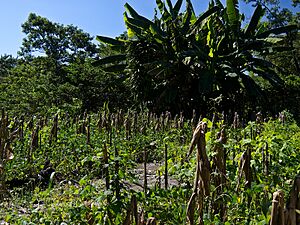Milpa facts for kids
Milpa is a special way of farming used in Mesoamerica, which is a historical region that includes parts of modern-day Mexico and Central America. It's a very old system, first used by the Maya peoples and other ancient groups.
The word milpa comes from the Nahuatl language, spoken by the Aztecs. It means "cultivated field." Even though people use the word in slightly different ways, it usually refers to a farming field.
Contents
What is Milpa Farming?
Milpa farming is known for growing three main crops together: maize (corn), beans, and squash. These three plants help each other grow. For example, corn stalks provide a pole for beans to climb. Beans add important nutrients to the soil, which helps the corn. Squash plants spread out on the ground, covering the soil and keeping weeds away.
This farming method is very clever because it helps farmers grow a lot of food without needing artificial pesticides or fertilizers. It's a natural and sustainable way to farm.
The Milpa Cycle
The traditional milpa system follows a special cycle. Farmers usually grow crops in a field for about two years. After that, they let the land rest for about eight years. This resting period is called "fallow." It allows the soil to recover its nutrients naturally, making it ready for farming again later.
Experts say this system is very good for the environment. However, if too many crops are grown too often, the land might not have enough time to recover, which could make the system less sustainable.
Different Meanings of "Milpa"
The word milpa can mean different things depending on where you are:
- In some parts of Mexico, like Jalisco and Michoacán, milpa can simply mean a single corn plant.
- In El Salvador and Guatemala, it often refers to the entire corn crop or a corn field.
- Sometimes, it describes a small field cleared from the jungle, farmed for a few seasons, and then left alone for a new clearing.
More Than Just Farming
The idea of milpa is much more than just a way to grow food. It's a big part of the culture and community in Mesoamerica. It involves strong connections between farmers, their crops, and the land itself.
For many indigenous communities, making a milpa is a very important and even sacred act. It brings families and communities together. Its cultural and social importance is often even greater than its importance for food or money.
Nutritional Benefits
The crops grown in a milpa are very good for you and complement each other nutritionally.
- Corn provides energy but lacks some important building blocks called amino acids.
- Beans are rich in these missing amino acids, making them a perfect partner for corn.
- Squash provides many different vitamins.
- Other crops sometimes grown in a milpa, like avocados, provide healthy fats.
Because of this amazing combination of crops, some researchers call the milpa "one of the most successful human inventions ever created." It provides a complete and healthy diet.
Milpitas, California
Did you know that the city of Milpitas, California gets its name from the word milpa? The name combines milpa with a Spanish ending that means "little fields."
See also
 In Spanish: Milpa para niños
In Spanish: Milpa para niños


